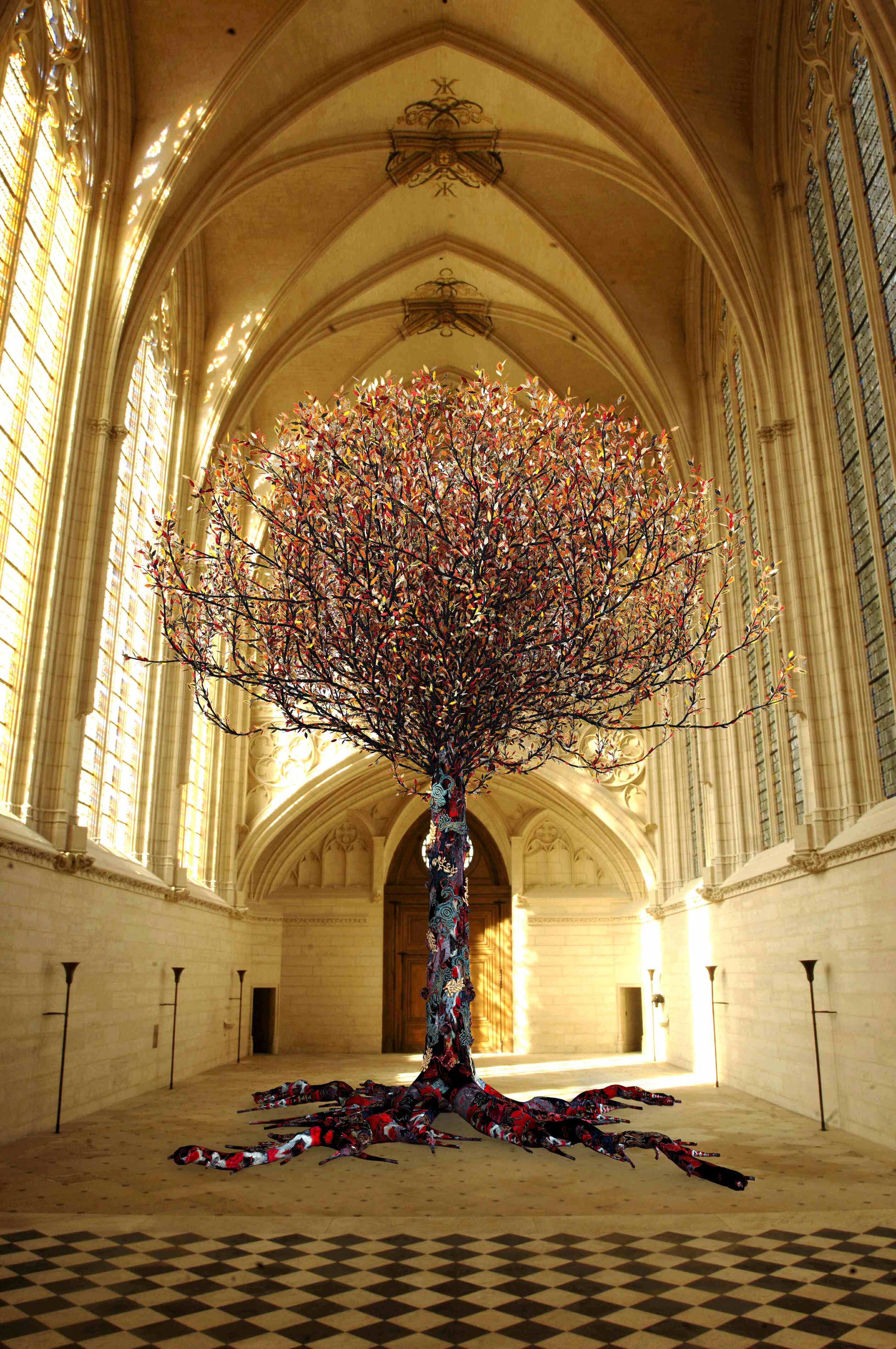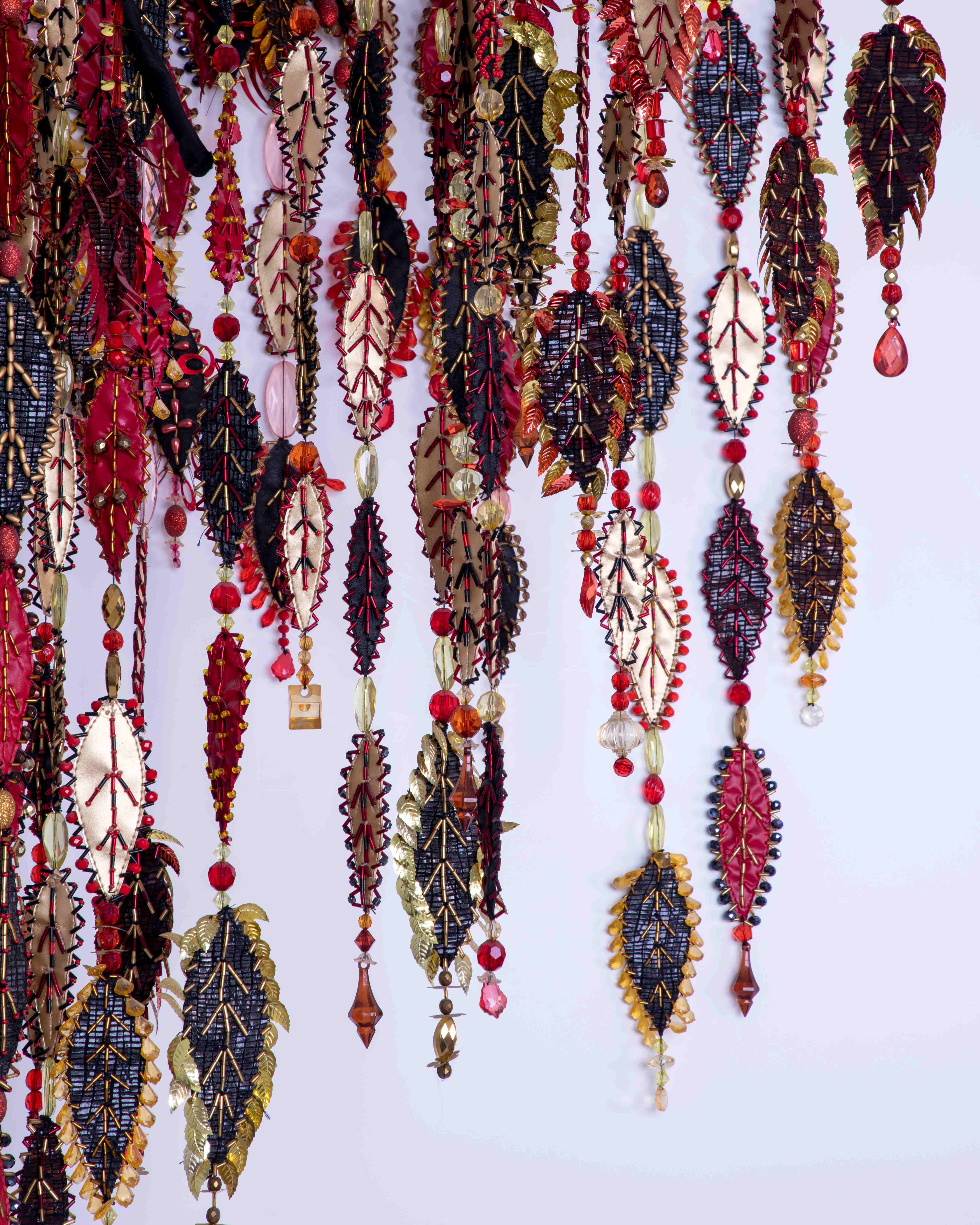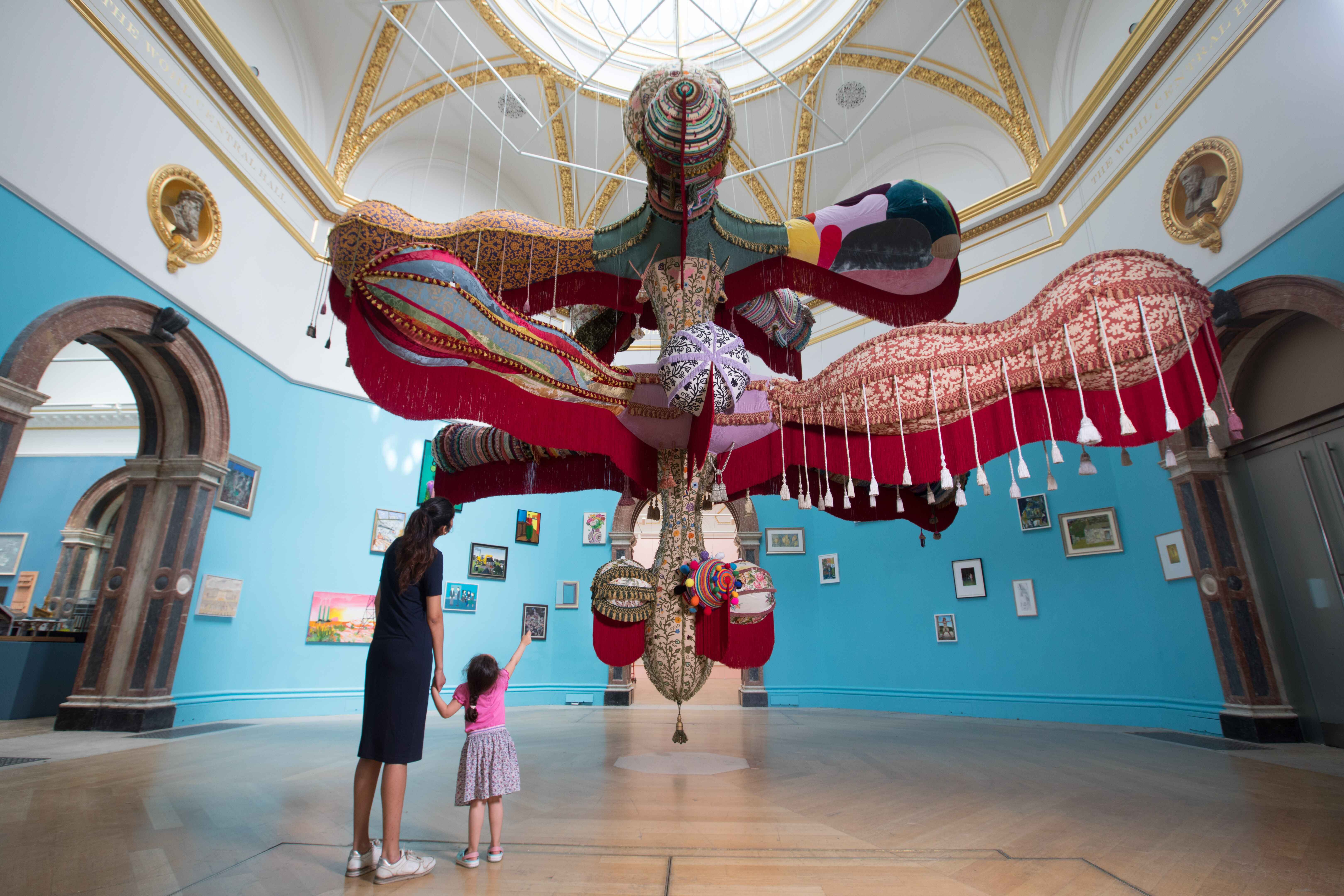Joana Vasconcelos is the epitome of joy and positivity. Despite the seven-month delay of the launch of her 13-meter-tall, site-specific work Tree of Life at Sainte-Chapelle de Vincennes, a Gothic royal chapel on the eastern edge of Paris, until April 2023 due to material shortages and technical difficulties, her sunny demeanor shines through.
 Tree of Life 3D rendering
Tree of Life 3D rendering
 Tree of Life artwork details
Tree of Life artwork details
The monumental installation is her interpretation of Italian sculptor Gian Lorenzo Bernini’s masterpiece Apollo and Daphne telling the tale of the river nymph Daphne from Greek mythology, who chose to be transformed into a laurel tree to repel the amorous advances of the god Apollo in a powerful gesture of independence and self-determination. “When I was invited to Sainte-Chapelle, I wanted to do something that was really extraordinary after Covid-19,” she states. “The incredible stained-glass windows at the back of the chapel depict Armageddon and represent the end of the world, while Tree of Life represents the beginning – it’s a symbol of renovation, hope, and life.”
Viewing every setback as an opportunity, during the pandemic-induced lockdown in Portugal, she had put her in-house craftspeople to work at home, hand-embroidering over 110,000 textile leaves using an ancient Portuguese technique from Viana do Castelo in the north of the country. Employing similar practices and fabrics as a couture house, with Vasconcelos as the couturier and her staff as expert seamstresses, they embroidered, crocheted, and knitted the tree sculpture.
 Royal Valkyrie
Royal Valkyrie
Vasconcelos’ works have always overflowed with native crafts since early in her career. “I really like to learn about local crafts from everywhere, but mainly from my country, because they transport a lot of information and a more intimate perspective in the sense that it’s really important to connect with tradition,” she says. “You cannot leave the present to create the future without having knowledge of the past.” Dialoguing directly with the architecture they inhabit, her multicolored, tentacular Valkyries series is named after famous women from history and based on the beautiful maidens of Norse mythology, who fly over battlefields to guide the souls of slain warriors. Often suspended from the ceiling, these mobile structures resembling otherworldly creatures are made entirely of hand-knitted, embroidered, sequin-strewn or crocheted sections. She discloses, “The fact that the Valkyries decide who gets to have a second chance is an important aspect because my Valkyries bring alive spaces, memories, and things that were forgotten, so in a way, I make this Norwegian tradition contemporary. The idea is to renew tradition.”
Whether a pair of high heels crafted from kitchen pots, a Venetian mask made from Baroque mirrors, a pistol constructed of old-fashioned telephones, or a heart formed from red plastic cutlery, once you get past the gargantuan scale and seductive spectacle of Vasconcelos’ creations, you’ll perceive more complex questions of gender, sexuality, femininity, cultural identity, consumer society, and the sustainability of the planet coming to the surface. She makes issues surrounding the private lives of people – especially the bodies, pasts, and traditions of women – public. Her 50-strong in-house team enable her to bring her increasingly outrageous ideas to life in a 3,000-sqm, four-floor atelier in Lisbon featuring separate departments dedicated to architecture, engineering, production, sewing, wood, metal, electricity, wellness, finance, and communication.
Although Vasconcelos’ sculptures are monumental in size, considerations of scale only come into play later in her creative process when thinking about the relationship of the piece with regard to the building or space, beginning first with the concept and investigating whether her sculpture is able to communicate her message and be understood or reflecting on her choice of materials. “Everything that surrounds me is a source of inspiration,” she notes. “The result of my work is the combination of my experiences, my personal life, and my family heritage. A flower, a movie, a concert, the people you meet and the conversations you have will always add something to who you are, and you cannot build an artwork without having something to say.”
Rather than a conservative Catholic family, Vasconcelos was raised in a revolutionary and intellectual household. She was born in 1971 in Paris, as her Maoist, left-wing parents had fled the Salazar dictatorship in Portugal and were granted political asylum in France. The family returned home following the Carnation Revolution in 1974, and Vasconcelos grew up in Lisbon. Her father trained as an architect then became a war photographer, her mother studied furniture restoration, her grandmother was a painter, and her aunt a poet and a writer. “When we went back to Portugal, my parents continued to follow their political ideals, but then they became part of the reconstruction of a country that had been shut down under a dictatorship for 47 years,” she recalls.
Vasconcelos’ breakthrough came with her first appearance at the 2005 Venice Biennale, where she presented her chandelier, The Bride fashioned from 25,000 tampons. Then she installed the Portuguese Pavilion aboard the Trafaria Praia at the 2013 Venice Biennale, transforming a cacilheiro Lisbon ferry into a floating work of art sailing around the Venice lagoon by covering it in Portuguese blue-and-white azulejos (hand-painted ceramic tiles). In 2012, she became the first female and youngest artist to exhibit at the Palace of Versailles. Her show was the most frequented in France in 50 years, registering a record-breaking 1.6 million visitors. The first Portuguese artist to display her works at the Guggenheim Bilbao, her major retrospective was among the world’s most visited exhibitions in 2018.
.jpg) Wedding Cake
Wedding Cake
Coming up next spring will be the unveiling of a temple to love measuring 12 meters tall by 15 meters wide in the shape of a three-tiered wedding cake, which Vasconcelos has been working on since 2017. The Wedding Cake pavilion set up in the sculpture park of the Rothschild family’s Waddesdon Manor in Buckinghamshire, England, will be her most ambitious project to date. Straddling the boundaries of art and architecture, it will showcase Portuguese Viúva Lamego ceramics on the outside and textiles within. Like a fairy tale come true, brides and bridegrooms will become part of the artwork when they enter it and exchange marriage vows, thereby transforming into the two figurines that usually stand atop a wedding cake.
Believing that artists open new paths for beauty and for understanding the world, Vasconcelos concludes, “The role of artists is to represent their time and their tribe and to give a new perspective on the world. Every artist is a reflection of his environment, his culture, where he lives, what he eats, the light, everything that surrounds him, and if you put together all the artists as we do at the Venice Biennale, you can get an idea of what the world thinks and aims for, its feelings, needs and concerns. It’s like monks in a monastery who do their job by reflecting to others a certain kind of spirituality and a certain kind of way. We do pretty much the same thing, but without religion and without a monastery.”







 Tree of Life 3D rendering
Tree of Life 3D rendering
 Tree of Life artwork details
Tree of Life artwork details
 Royal Valkyrie
Royal Valkyrie
.jpg) Wedding Cake
Wedding Cake



-NAC Facade L2.jpg&w=500&h=550&crop-to-fit)
 Back
Back
